Years ago we covered using thermite to destroy a hard drive. The idea is that if you melt through the platters, the data is completely unrecoverable. There are tons of videos of people doing this, but they all have a similar format. There’s a hard drive, with a flower pot or soda can sitting on top full of thermite. They then light this with a strip of magnesium and a torch.
I wanted to do something a little different. I wanted to implement thermite as a self destruct mechanism inside the device. To do this, I had to come up with a way to ignite the thermite. This stuff is very difficult to light. You have to get it really really hot. The easiest way is to use magnesium, which itself isn’t the easiest thing to light.
What I finally landed on was an ignition system that uses model rocket igniters, gun powder, and magnesium to light the thermite. The model rocket igniter can be set off from the 12v line inside your computer. However, it isn’t hot enough to light magnesium shavings, much less thermite. To get it to work, I needed to add some gunpowder. A small amount of gun powder would get hot enough to light the magnesium shavings, which in turn were hot enough to light the thermite. I had to be careful though, because too much gunpowder would cause a rapid expansion, blowing the thermite everywhere instead of lighting it. You can actually see some red thermite being blown out of the external hard drive and the laptop as the gunpowder ignites.
Effectiveness of external hard drive self destruction:
I wasn’t sure about this one. There isn’t a whole lot of space for thermite and the ignition system inside the box. On top of that, the only space was at the side of the hard drive, where the walls are the thickest. I had no idea if the small amount of thermite I used would penetrate the drive. It did, just barely as you can see in these pictures. It looks as if it pooled in the screw holes and made it inside. The platters are damaged.
Effectiveness of laptop destruction:
I decided to completely replace the cd rom with thermite. This gave me a ton of space to put things. I was pretty positive this would work. The hard drive is in the center of this laptop, which meant I had to place it on its side for this to be effective. You can see the thermite work its way down toward the drive in the video. As you can see in the pictures below, the drive cover is completely gone and the platters are destroyed. Success!
Since this system can be powered by batteries or the internal power of your computer, it can be put inside a working device only to be used when needed. Obviously it is a ridiculous fire hazard that no one should bother with. It was a fun experiment though and I really feel like it is something that would fit in well in the world of [James Bond]





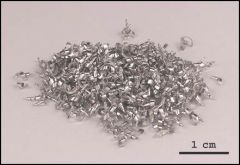
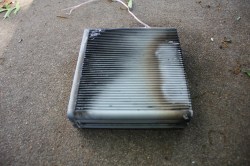
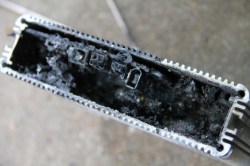
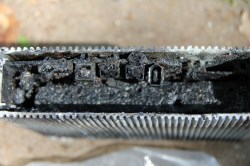
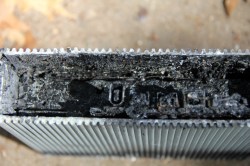
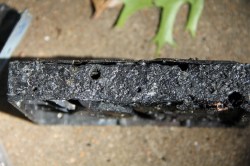
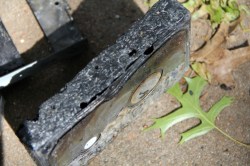
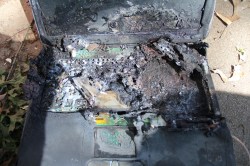

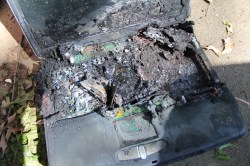
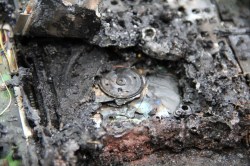
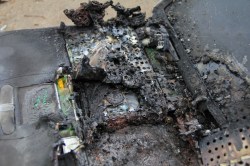
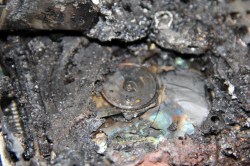














I think I have just found a neat summer time project. Thanks Caleb, for the incredible dangerous inspiration.
Did you take the battery out before testing the laptop?
yes I did. You can see in the real time footage that the battery is removed.
Taking the battery out before setting off thermite is like sanding the ice around some dynamite, or making sure your cyanide is free from poisonous lead and mercury compounds…
where’s the like button?
Points for wit but not entirely true.
Thermite is pretty safe. It won’t explode and shower you in acid and molten casing. It’s just a bit hot and blinding but as you saw in the video most of the light was contained by the cases anyway. And themite is very non toxic. If you wanted to you could happily eat some.
it is as safe as something that burns as hot as lava can be. It is extremely stable when not lit, so risk of accidents are quite low. You’re actually in more danger of breathing the fine powders than of accidentally igniting thermite. Any fine powder can be harmful.
Once it is lit however, you can’t really put it out very well, and just like all molten metals, you don’t want to touch it.
Not entirely true either, thermite can cause molten metal to fly quite far.
Lithium Ion batteries are not that dangerous, the chemicals aren’t very corrosive, they are slightly flammable though.
Thermite might be more or less safe, but the fumes from burning electronics and plastics are FAR from safe. Be warned!
The Hindenburg was “painted” with a mixture now known to be a cross between compounds commonly used as rocket fuel these days, and thermite. I wonder, if “painting” the inside top and bottom shell of a laptop with thermite would allow for a sufficient amount to render the data permanently lost? This way there is no risk of separation, and provides an even “top-down” burn, no matter the laptop orientation…
Nice idea. Does it take a lot of thermite to produce this reaction? Would a smaller amount be just as destructive? (looks like a LOT of flame) Also, seeing as you had to turn the laptop on it’s side for the thermite to get to the hdd, I assume that there was no space to place it on top of the hdd. Does thermite need air space to react properly? i.e. Does thermite not ignite when packed into a tight space? I have never had the luxury of space to try this out in.
you might be able to destroy that laptop hard drive with about half what I used. Maybe less if you could position it on top of the drive. I had space, so I added more for effect.
Thermite can ignite when compressed, but it will expand, which would be unwanted here. I wanted it to pool on the hard drive.
Kool, ok. So, say if you wanted you *could* place a small, thin pack on top of the hdd and keep the destructive effects but without quite a show. I may have to find somewhere to try this out. Awesome!
I’d be interested in how thorough the destruction would’ve been if your laptop’s harddrive had the thicker 3.5″ style platters. Of all of the laptop harddrives I’ve seen, they seem to be made of very thin glass that you can snap with a finger, while desktop harddrive platters are made of something that’d require a hammer, if they aren’t just straight bendable metal (I’ve heard they’re ceramic, but have never tried to break one to confirm)
a half cup of thermite will eat a stack of desktop drives. What you see going into the external hard drive is maybe 2 tablespoons worth. It still eats into the drive and damages it. If it had been placed on the thinner top cover of the drive, it would have possibly gone all the way through.
Hard drive platters are usually made of either ceramic or aluminum. I have a 6″ thick stack of aluminum hard drive platters that I use as drink coasters.
“next time” (!) – if the laptops working, you could write a little countdown program. When it hits zero, it sends a signal to the printer port, trips a 5V relay, and send +12 to the detonator! No better, but more cool factor. :D
I considered that. Just didn’t follow through on this one.
Great… now the TSA’s gonna be inspecting our laptops for thermite!
if the TSA isn’t already checking for gunpowder, magnesium, and thermite, I’d be quite surprised.
Given many better laptops are already built on a magnesium casting they’re SOL there.
Most T-series Thinkpads are magnesium AND carbon fiber. :J
When NeXT was bankrupt(?), a reporter wanted a cover picture for a magazine with a NeXT cube burning. He managed to get a non-painted (with the flame retardant paint) chassis from the company and thought it would be as easy to ignite as the proverbial magnesium strip you ignite in high school.
Turned out that it’s a Magnesium alloy, which is very resistent to fire. the magazine cover picture was the cube siting in an oven, not bursting into flames… there’s a write up of the picture tale somewhere.
Wed, 24 Mar 93 Simson Garfinkle burned the cube.
NeXT wasn’t bankrupt, What they did in 1993 was anounce the end of NeXT hardware, the company continued as a software company. NeXTSTEP 3.3 was released in 1995, OPENSTEP 4.0 in 1996 for HP PA-RISC, SPARC and Intel processors , and broke all my old code, old binaries would run but the code needed changes to recompile, Object was no longer the root object. Motorola might share a bit of the blame for the demise of the hardware end of the buisness. The 68060 was late, didn’t come out until 1994 and Motorola killing off the 68000 processors caused them a bunch of trouble, no future. Only a handful of Turbo cubes and slabs were made. Jobs was negotiating his return to Apple, February 4, 1997, Apple Computer acquired NeXT for $429 million.
NeXT cases were made here in Chicago, I had some dealings with the company that did the casting for them back then,.
Not just a reporter, it was Simson Garfinkle.They burnt the Cube at Lawrence Livermore National Lab http://en.wikipedia.org/wiki/Simson_Garfinkel
http://simson.net/hacks/cubefire.html
Someplace I still have the issue of NeXTWORLD this was in.
A few g of some high explosive around the HDD to scatter the HDD platters would be a better choice, because it’s much faster and a lot less energetic material is needed. And who cares about the fingers of the person who has stolen your (of course unencrypted) top secret stuff. If you use an encrypted HDD, you won’t have those problems
If positioned properly you could probably use explosives to damage the platters beyond readability without breaching the case of a laptop or (metal) external drive.
To fully destroy the magnetic fields on a HDD you need heat, and enough to melt the metal of the platters. Otherwise the data can be recovered from the platters using a Magnetic force microscope. There is a lot of error correction built into the stored data. At the lowest level of a modern hdd there are recoverable faults on more reads than you would expect, way more, than is displayed to you through S.M.A.R.T.
I cringe thinking about the read rate through a microsope. Imagine sifting through a 3tb hard drive – Its going to be slow – i would guess the scope moves not the platter unless you get a cnc table that moves quick under the scope it has got to be painstakingly slow. Is this actually done?
It is done, if the data has a high enough finical value (think fortune 500 companies CEO’s laptop, with data on it so sensitive that it can not be stored on the fileservers or on backups). There are a few companies that specialize in this type of recovery and it is not cheap. I always think of the magnetic scans/photos produced as something akin to what you would find on the Silicon zoo (http://www.siliconzoo.org/) for decapped microchips. Once they have the full magnetic scan/photo then they need to send inputs (SATA commands) into the simulated virtual HDD electromechanics (which I’m sure is different for each vendor due to patent space) and return the expected outputs (bytes on the disk). I can not imagine any company working in this space not to have a bunch of NDA’s with all the HDD manufacturers, to make that part easier. And nowadays I’m sure that they would also have NDA’s with enterprise HDD encryption vendors as well.
Of course this only applies to spinning rust, I wonder what you do with damaged flash storage. i can not imagine the data being recoverable, but it would be interesting to know.
With regard to flash chips, its all about the $$$$, given enough you can get the data out, as long as it was not bulk erased, then you have a much tougher time. Think a bunch of wires going to a bare die, worst case you need to FIB some new traces etc, but it can be done, I know… got the Tee shirt
What do you think of a small shaped charge? I don’t know if the small scale of it would render a device ineffective, but perhaps a V-channel of copper with the appropriate charge and tamper surrounding the drive on three sides could generate a sufficiently powerful jet of molten metal to pierce the casing and destroy the platters. (I apologize for the run on sentence) The nature of a shaped charge should also provide for minimum collateral damage as well. Just food for thought.
A shaped charge is an interesting idea, maybe in a spiral V-channel pattern. But the problem is if you look at the platters in a HDD as books, the shaped charge would be akin to ripping out pages Wherever they melted the platters the data would be gone, and any unmelted parts could still ave data recovered. It would make the recovery job a hell of a lot more difficult.
The easiest way I have heard of to fully destroy data is to use strong encryption on the HDD, store the strong (very long) keys on a USB stick and use explosives on the USB stick. The nice thing is that the USB stick does not need to be near the computer. I do not know if anyone has implemented the idea, but it is appealing.
Well, most neodymium magnets lose their magnetic properties when they reach a temperature of 400 degrees C. Since thermite can reach 2500 degrees C, I think the magnetic fields on the drive platters will be sufficiently scrambled to prevent recovery.
I personally do not know the composition of the spinning rust on a platter. I would assume that it is not neodymium for a lot of reasons. I do know that the platters under the magic magnetic coating are aluminum which has a melting point of 660.3 °C and that the highest Curie temperature, that I know, is for Cobalt (1388 K). So i would pick one of these temperatures as the goal and not the melting point of neodymium. What needs to happen is for the casing of the HDD to melt and for the heat source to drip onto the platters otherwise the radiant heat through air from the casing to the platters has to be high enough to get the platter temperature on both sides to a minimum of 1115°C (1388 K). This would be to know for sure that the data is gone gone gone forever. Otherwise the coating may leak out all the aluminum and leave the coating in place a bit like an empty bag with the data still on the surface.
Fantastic version of Chopin’s Funeral March (better known as “pray for the dead and the dead will pray for you”). Where’s it from, where can I find it?
Also, this post is straight up awesome! Takes “will it float” to a whole new level!
it was made by Kevin MacLeod at Incompetech.com
Awesome, thanks!
Most of the time I’m against music in videos like this, but this song is perfect
thanks!
What’s your way to get the aluminum and iron oxide powder?
go to amazon.com. search for aluminum powder. Iron oxide will most likely be in the suggested items down below.
It takes time, but you can also acquire your own iron oxide using a DC adapter. ;)
and magnesium shavings can be had from volkswagen engine blocks or transmission bell housings.
Magnesium can be easily acquired in stores in the form of a 3″ long fire-starter sold as a camping accessory.
go to alphachemicals.com they sell thermite packages already in the proper ratio. its 13 bucks for 4 pounds
is that an omnibook?
on fire?
http://nooooooooooooooo.com/
Kevin Rose did this about 12 years ago (or so) – sometime after The Screensavers and before he created Digg.
He had this show called The Broken. He also interviews Kevin Mitnick in this episode, so it’s worth watching all the way through.
http://www.youtube.com/watch?v=rcWByfwkf4k
man this program is awful! the typical WASP feeling criminal and listening the rap. classic. but thanks for sharing this.
A true Dangerous Prototype! ;-)
A few notes on igniting thermite:
The particulate size and shape of your aluminum plays a huge role in how it ignites and burns. It all comes down to surface area for the reaction. A fine, non-spherical (or flake) power will ignite remarkably easily. German blackhead is by far the best here. However, you only want this to initiate the reaction. You want to use larger particles for the bulk of the reaction to insure that it does not progress to rapidly. Again, you want non-spherical aluminum so that the reaction can start on the edges.
Instead of using a potassium nitrate/charcoal/sulfur initiator — which not only burns very quickly but is also a gas generator — you can use aluminum/sulfur. The aluminum/sulfur reaction will occur at a relatively low temperature and generate enough heat to initiate the thermite reaction.
If my memory serves me correctly. I remember Aluminum/Sulfur mixtures as being moisture sensitive, in a very bad way.
If you want to render any stored data totally unreadable just use a hot swap drive. This method works with both a platter drive or a SSD. When the proverbial knock at the door comes, just pull the drive, place it on top of an induction bearing heater & flip the on switch. Go answer the door. By the time the intruders get to the drive any ferric material will be red to yellow hot, and the very powerful oscillating magnetic field will have made any chance of reading the drive impossible. Unless of course they possess a time machine.
This message will self-destruct in 10 seconds…
RE Lighting; you can usually buy “PotPerm” (Potassium permanganate) from plumbing supply stores. Glycerol, anti-freeze or hand sanitizer can be poured on the potperm to ignite the thermite.
FLAGRANT SYSTEM ERROR
Computer Over.
Fire = Very Yes.
I like this.
That’s not a good prize.
Gotta keep with POSIX syntax.
lp0 on fIre
CPU#0: Possible thermal failure (CPU on fire ?)
/dev/sda on fire
;-)
I see an “on fire” in there, but it’s getting eaten by some… Linux or something…
Wait, is this one of those virus comments?
What would be a real hack is making a miniature device with a very small amount of thermite that you mount inside the hard drive next to the platters. You would then have the device wired to the read/write head through the control board, listening for a certain pattern (ie file) to be read or written. If a certain file is read off the device or if one is written on, boom goes the drive. You could also have a defuse file and other safety mechanisms.
I could see this as being an easy way to deal with the situation, however how long would it take for someone to engineer a virus to do the writing? I would think a hardware igniter would be lesser of the evils. Perhaps more complicated, but definitely safer for the owner.
“What do you mean ‘Thermite voids my warranty’!?” Very cool, but I would have liked to seen it activated from the battery, who has time to plug in their laptop when they have to melt their hard drive?
it could easily be activated from the battery. I just removed it so I wouldn’t have to deal with a melted laptop battery.
Are hard disk platters conductive? If so, you could also try to use heating by induction to wipe the data….
There was nothing to fear, and nothing to doubt. Absolutely cool stuff!
hypothetically speaking, would this still work if you found a genie about 8 months ago and wished for an indestructible hard drive so you wouldn’t have to back up your data?
Hey Caleb,
wanted to know from where can someone get that aliminum enclosure that got burned?
s
To solve the space problem: You might use a 1.8″ HDD with an 2.5″ adaptor and fill the space you won with the thermite.
And how about using NiChrome or Kanthal wire for ignition? They survive more than 1000°C so you should be able to ignite the Magnesium with it.
To get NiCr that hot wou’ll need more apms than I’m sure are available…
how about a cap? didn’t try that yet but e.g. a flash capacitor should put out enough amps. Then you’ve got another space problem, though.
Sparklers can be ignited by model rocket starters and contain magnesium. Not sure how well a sparkler would light thermite, but it would be a cheaper and easier alternative than making you own gunpowder and magnesium compound.
Sparklers ignite thermite pretty well, used them for an experimental series. They are more reliable though if you use three of them, also you can scratch the powder off for more reactive surface.
btw, sparklers don’t contain magnesium but powdered iron.
Termite, in something that you keep in your lap. nice!
Yeah, they might eat your wood.
you aint seen nothing till youve seen what thermite does to an iMac
From the 1971 Esquire article “Secrets of the Little Blue Box”: “I thought of everything for this model. I had it lined with a band of thermite which could be ignited by radio signal from a tiny button transmitter on your belt, so it could be burned to ashes instantly in case of a bust. It was beautiful. A beautiful little machine.”
Thanks for doing this project, it’s been on my to-do list for a very long time, great to see it implemented.
At th moment we are in what seems to be perpetual burn bans/restrictions. We have to call law enforcement dispatch to light any outdoor fire to get approval. After the name location information they ask what you are burning. What are you burning? computer hard drives. After approval the broadcast the controlled burn location, and the nature of the burn. In this rural county many know it is who will burning what as soon as they hear the address.
Well, you should be aware that burning plastics, like PVC covers and cable insulation, emits health dangerous and poisonous gases liked dioxanes and chlorium gas. As spectacular as it is such an act it should not be done lighthearted and you ought to discourage others from repeating it.
I wonder what the TSA will think when they discover that your laptop is rigged to burst into a hellish inferno and the press of a button?